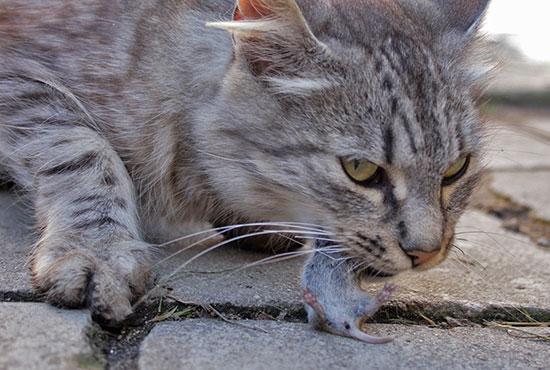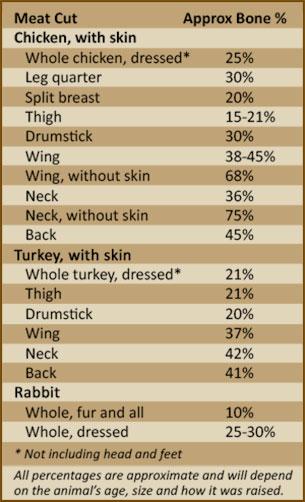This content is archived from the Feline Nutrition Foundation
Don't Let Calcium/Phosphorous Ratios Scare You
- Updated: Sunday, June 02, 2019 02:37 PM
- Published: Saturday, November 22, 2014 08:50 PM
- Written by Elisa Katz, DVM
 It is widely known that cats have a dietary need for both calcium and phosphorous. Calcium is required by the body, not only for bones, but also for muscle control and ion balance. Phosphorous is important in the formation of bones and teeth, and also plays vital roles in cell membranes and energy processes.¹ Phosphorus is a structural part of cells; this is why meat tissue has high levels of it. Phosphorus is attracted to calcium, forming calcium phosphate, which is what gives bones and teeth their strength. Just as important, and possibly even more so, is the ratio of calcium to phosphorous in the diet. Like big cats, the domestic cat is an obligate carnivore whose ancestral diet of whole prey would serve to provide the proper amounts of both of these minerals in the ideal ratio for cat nutrition. This is because by weight, the cat's typical prey consist of about 7-10% bone.²
It is widely known that cats have a dietary need for both calcium and phosphorous. Calcium is required by the body, not only for bones, but also for muscle control and ion balance. Phosphorous is important in the formation of bones and teeth, and also plays vital roles in cell membranes and energy processes.¹ Phosphorus is a structural part of cells; this is why meat tissue has high levels of it. Phosphorus is attracted to calcium, forming calcium phosphate, which is what gives bones and teeth their strength. Just as important, and possibly even more so, is the ratio of calcium to phosphorous in the diet. Like big cats, the domestic cat is an obligate carnivore whose ancestral diet of whole prey would serve to provide the proper amounts of both of these minerals in the ideal ratio for cat nutrition. This is because by weight, the cat's typical prey consist of about 7-10% bone.²

What is the ideal ratio and how can you ensure that your cats are getting proper amounts of calcium and phosphorous? Calcium to phosphorus ratios are typically written like this: 1.1:1, with the first number representing calcium and the second phosphorus. The ideal ratio of calcium to phosphorous in the feline diet is approximately 1.1:1. However, the ratio can vary from 0.9:1 up to 1.5:1 without any adverse consequences.³ Daily balance is not as vital as the overall balance over time, in weeks to months.
How can this ratio of calcium to phosphorous be achieved in addition to ensuring that your kitty gets adequate amounts of both of these vital minerals? The answer is simple. As mentioned previously, most prey species the cat would eat, such as mice, small birds and rabbits, consist of about 7-10% bone by weight and yield a ratio of about 1.1:1. Therefore, to achieve the proper calcium to phosphorous balance and properly mimic the ancestral diet, we can feed approximately 7-10% raw bones as part of the diet. We have provided a chart with the approximate weight percentages of bone for commonly fed bone-in cuts.
If you are making your own ground raw cat food, follow "Feline Nutrition's Easy Homemade Cat Food Recipe" to ensure the correct calcium to phosphorus ratios. Alternatively, bone meal, dehydrated bone or eggshell calcium may be used in the appropriate amount. This will vary depending on the actual product used. Lastly, commercially available pre-made and pre-balanced raw cat food meals are available. Remember that each individual meal does not need to be in the correct ratio, rather, the ratio needs to be balanced over time. Feeding a meal of chicken necks, which have a bone percentage of about 36%, is fine as long as it is balanced by a meal or meals with a lower bone percentage.
Adequate amounts and proper balance of these two vital nutrients is extremely important to your cat's health. Too little calcium in the diet can result in calcium being pulled from bones and may lead to fractures, weakness and even seizures and death. Too much calcium can lead to growth problems or increased bone density leading to orthopedic issues. Too much or too little calcium can contribute to constipation. Inadequate phosphorous is extremely rare but can lead to hemolytic anemia and acid-base imbalance. Excess phosphorous is not known to be a problem except with cats with compromised kidney function.
Additional Reading
Answers: Raw Food for Cats, What About Eating Bones?
Answers: Kittens Go Through Teething, Too
Remember that daily balance is not as vital as long term balance. Feeding an improperly-balanced diet for days to a few weeks is not likely to be a big problem unless you have a growing kitten. Beyond this time period, a lack of proper calcium to phosphorous balance is likely to result in health problems for your kitty. If you follow the recommendations above this should not be a concern for you.
Dr. Elisa Katz, DVM, is a graduate of Ohio State University and is the owner of Natural Pet Animal Hospital in Bourbonnais, Illinois. She practices holistic and integrative medicine focusing on proper diet and nutrition. Dr. Katz shares her home with four kitties and one dog.
1. Michael S Hand, DVM, PhD; Craig D Thatcher, DVM, MS, PhD, Rebecca L Remillard, PhD, DVM, and Philip Roudebush, DVM, Small Animal Clinical Nutrition, 4th ed. Walsworth Publishing Company, 2000, 71-74.
2. Ellen S. Dierenfeld, PhD, Heather L. Alcorn, BS and Krista L. Jacobsen, MS, "Nutrient Composition of Whole Vertebrate Prey (Excluding Fish) Fed in Zoos," U.S. Department of Agriculture, May 2002.
3. Michael S Hand, DVM, PhD; Craig D Thatcher, DVM, MS, PhD, Rebecca L Remillard, PhD, DVM, and Philip Roudebush, DVM, Small Animal Clinical Nutrition, 4th ed. Walsworth Publishing Company, 2000, 310-311.




